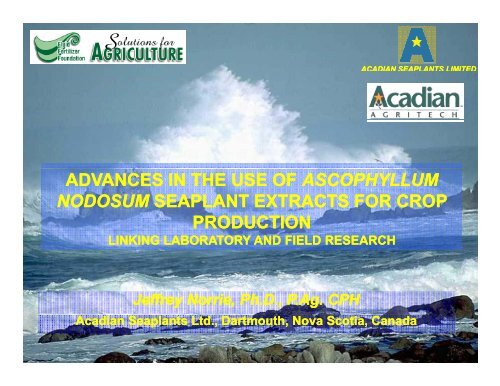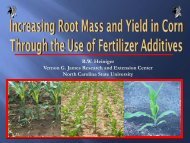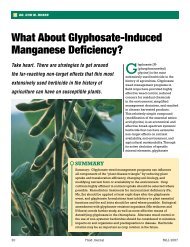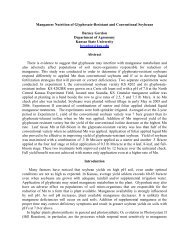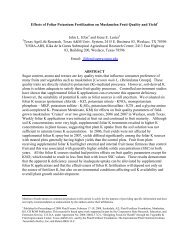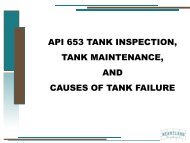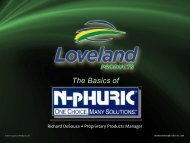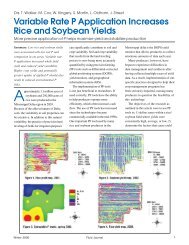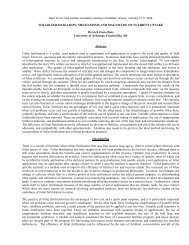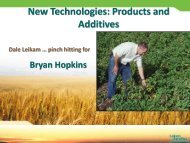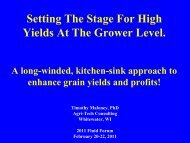J. Norrie - Fluid Fertilizer Foundation
J. Norrie - Fluid Fertilizer Foundation
J. Norrie - Fluid Fertilizer Foundation
Create successful ePaper yourself
Turn your PDF publications into a flip-book with our unique Google optimized e-Paper software.
ACADIAN SEAPLANTS SEAPLANTS LIMITED<br />
LIMITED<br />
ADVANCES IN THE USE OF ASCOPHYLLUM<br />
NODOSUM SEAPLANT EXTRACTS FOR CROP<br />
PRODUCTION<br />
LINKING LABORATORY AND FIELD RESEARCH<br />
Jeffrey <strong>Norrie</strong>, Ph.D., P.Ag. CPH<br />
Acadian Seaplants Ltd., Dartmouth, Nova Scotia, Canada
M Maine, i USA<br />
USA<br />
Major Processing Facilities<br />
New Brunswick<br />
Yarmouth, NS<br />
Pennfield, NB<br />
Cornwallis, NS<br />
Charlesville, NS<br />
Prince Edward Island<br />
Nova Scotia<br />
Head Office<br />
Dartmouth, NS
www.acadianseaplants.com
Hana Hana-nori nori
Alimentation animale
Ascophyllum nodosum “Norwegian Kelp” or “Knotted wrack”
Bay of of Fundy<br />
Fundy
R&D Challenges<br />
Main product for agriculture:<br />
Ascophyllum nodosum algal extracts<br />
Research from lab to field on achieving<br />
maximum benefit from seaweed extracts<br />
Technology Transfer of information to<br />
Sales and Marketing<br />
Get best-use information into the hands of<br />
growers and market partners
R&D Challenges<br />
Different countries, different crops, different<br />
varieties, different growing conditions (soil,<br />
water, t atmosphere, t h crop programs) )<br />
Research field trials, coop trials, joint trials<br />
Draw on expertise from greater scientific<br />
community y to examine seaweed pproducts<br />
to understand best use strategies
Stimulate proteins and<br />
growth promoting<br />
compounds<br />
Enzymes production<br />
Mediate cellular processes<br />
Defensive proteins<br />
Structural proteins<br />
Anti-oxidants<br />
Protection against biotic and<br />
abiotic stress<br />
Different fractions<br />
Different active ingredients<br />
Different growth stages<br />
Different crops<br />
Interactions with other<br />
crop inputs<br />
Ascophyllum nodosum<br />
Biostimulant-Nutrient activity<br />
Growth response (cell division and Cause-effect<br />
differentiation) bioassays<br />
Cell filling<br />
Foliar nutritional component<br />
Fruit filling<br />
Better yields<br />
Bud retention and fruit set<br />
Longer shelf life<br />
Higher fruit number<br />
Better fruit quality
Challenge<br />
• Sensitivity<br />
How do we show differences between treatments?<br />
Remove experimental error<br />
• Cause and effect<br />
• Provide scientific explanations<br />
• Data Data Data
ASL ASL R&D R&D Center Center for for Innovation<br />
Innovation<br />
Cornwallis Business Park, Clementsport, Nova Scotia
Benefits of Ascophyllum extracts<br />
Many benefits are attributed to<br />
seaweed extracts<br />
How are these identified?<br />
How do we best use seaweed extracts<br />
in Agriculture?<br />
Starts with examination of our species,<br />
extraction technology and base<br />
constituents.
What is is Ascophyllum Seaweed<br />
AC A Complex l mix i of: f<br />
Extract?<br />
• Plant growth regulators<br />
AAuxins, i Gibb Gibberellins, lli CCytokinins, t ki i BBetaines, t i<br />
• Amino acids<br />
• Organic acids<br />
• Carbohydrates<br />
• Vitamins<br />
• Macro- and micro-nutrients
Plant Growth Hormones<br />
___________________<br />
AUXINS<br />
CYTOKININS<br />
Indole acetic acid<br />
Trans-zeatin a s eat<br />
dihydro-zeatin<br />
dihydro-zeatin riboside<br />
trans trans-zeatin zeatin riboside<br />
ABSCISSIC ACID<br />
Isopentyladenosine<br />
isopentyladenoside<br />
GIBBERELLINS<br />
GA 3<br />
GA 4
Other Bioactives of Interest<br />
Oligosaccharides Polyphenolics
Betaine Levels (ppm)<br />
Sample GB ABAB AVAB<br />
A. nodosum M1 15 15-30 30 150 150-350 350 50 50-60 60<br />
SSEP 30 30-60 60 130 130-260 260 100 100-200 200
Acadian Seaplants R&D<br />
What kinds of projects p j are we looking g at?<br />
Active ingredient identification:<br />
HPLC technologies<br />
Carbohydrate profiling<br />
Plant Hormones<br />
Gas Chromatography/Mass spectrometry<br />
Specific molecules<br />
NMR technologies<br />
Comparative profiles of molecular constituents<br />
In vivo testing
NMR Spectra of ASL Extracts<br />
Localities and Seasons<br />
Ingomar NS Sep 2004<br />
Barrington NS Jun 2004<br />
Bear Point NS Mar 2004<br />
Glenwood NS Jan 2004
PC2<br />
Principal Components Analysis of 1H-NMR NMR Spectra<br />
14<br />
12<br />
10<br />
8<br />
6<br />
4<br />
2<br />
0<br />
-2<br />
-4<br />
-6<br />
-8<br />
-10<br />
-12<br />
A_15<br />
B_2<br />
A_14<br />
F_1<br />
L_1<br />
B_1<br />
E_2<br />
C_1<br />
E_3<br />
L_2<br />
A_2<br />
A_9 A_4<br />
A_11A_12<br />
A_5<br />
A_13 A_10<br />
A_3 A_1 A_6<br />
A_8<br />
A_18<br />
I_3<br />
A_19<br />
A_43<br />
A_21<br />
A_25 A_41<br />
A_31 A_23 A_27 A_28<br />
A_38 A_39 A_22 A_29<br />
A_32 A_30A_20<br />
A_24<br />
A 26<br />
A_33 A_34<br />
A_36 I_1I_2 J_1<br />
A_26A<br />
A 40 37 A_ 42 _<br />
A_40 A_37<br />
A_35<br />
A_42<br />
E_1<br />
A_16<br />
A_17<br />
I_4<br />
H_1 H_2<br />
-10 0 10 20<br />
PC1<br />
K_1<br />
K_2<br />
G_1<br />
D_1
PSA Assay, Absorbance<br />
@ 480-490nm<br />
PSAA<br />
Assay, Absorbance @ 480-490nm<br />
4<br />
0.3<br />
0.25<br />
0.2<br />
0.15<br />
0.1<br />
0.05<br />
HPLC Ultahydrogel Profile with PSA Assay<br />
Acadian SSEP 4318 (A1-04)<br />
Very large 1,000kDa 500kDa 100kDa 50kDa 10kDa 1kDa<br />
PSA S Assay<br />
RI Output<br />
0<br />
15 17 20 22 25 27 30 32 35 37 40 42<br />
Elution time, min<br />
1<br />
0.9<br />
0.8<br />
0.7<br />
0.6<br />
0.5<br />
0.4<br />
0.3<br />
0.2<br />
0.1<br />
HPLC Ultahydrogel Profile with PSA Assay<br />
LSE Pressurized Cook<br />
Very large 1,000kDa 500kDa 100kDa 50kDa 10kDa 1kDa<br />
PSA Assay<br />
RI Output p<br />
0<br />
15 18 20 23 25 28 30 33 35 38 40 43<br />
Elution time, min<br />
139.4<br />
138.4<br />
137.4<br />
136.4<br />
135.4<br />
134.4<br />
140.6<br />
138.6<br />
136.6<br />
134.6<br />
132.6<br />
130.6<br />
Index Output mV<br />
Refractive<br />
Refractive Index Outputt<br />
mV
Points to Consider<br />
Different seaweed products are made in<br />
different ways.<br />
Diff Different products d have h different diff bioactivities<br />
bi i i i<br />
Need to identify y these actives in various<br />
marine plant products<br />
Need to connect activities to specific plant<br />
responses<br />
Genetic/molecular responses
AAnti-oxidants ti id t<br />
Phenolics<br />
Phytoalexins<br />
Hypersensitive<br />
yp<br />
response<br />
Betaines<br />
GABA<br />
Vitamins<br />
Salicilates<br />
Jasmonates<br />
Brassins<br />
Hormones<br />
(stimulants /<br />
retardants<br />
Organic<br />
Acids<br />
Amino acids<br />
Polyamines
Stimuli
Stress Resistance<br />
S Superoxide id dismutase di t in i creeping i bentgrass b t<br />
SODD<br />
activitty<br />
(x 10000<br />
unitss/g<br />
DM)<br />
20<br />
15<br />
10<br />
5<br />
0<br />
Low N High N<br />
Treated Control<br />
Virginia Polytechnical University, 1997
Ascorbate peroxidase activity in<br />
tall tall fescue<br />
fescue<br />
Asscorbate<br />
peroxidasse<br />
activityy<br />
(µmoole/h/g<br />
fr. wt.)<br />
3500<br />
3000<br />
2500<br />
2000<br />
1500<br />
1000<br />
500<br />
0<br />
E+ EE-<br />
Seaweed No Seaweed<br />
Virginia Polytechnical University University, 1997
P/S capacity in creeping bentgrass<br />
IImproves photosynthetic h t th ti efficiency ffi i<br />
Photosyntheticc<br />
capacitty<br />
(Fvm690)<br />
03 0.3<br />
0.25<br />
0.2<br />
0.15<br />
0.1<br />
0.05<br />
0<br />
Low N High N<br />
Treated Control<br />
Virginia Polytechnical University, 1997
Resistance to Disease Stress<br />
University of Avignon, 1998
Resistance to Disease Stress<br />
University of Avignon, 1998
Soil Applied<br />
Direct induced SAR<br />
Increased<br />
root & shoot<br />
growth<br />
Alarm reaction<br />
induced SAR<br />
RE<br />
Greener<br />
foliage<br />
Feeds<br />
microbes<br />
(fluorescent<br />
Pseudomonads)<br />
Greater<br />
resistance es sta ce<br />
to soilborne<br />
fungal<br />
ß-1,3-glucanases<br />
Fe<br />
Siderophore<br />
production<br />
diseases<br />
(Antagonism)<br />
(Fungal hyphae)<br />
Seaweed extract:<br />
At least 2 applications<br />
‘Primer’ Primer & & ‘Activator’ Activator<br />
(Fe & Laminarin +<br />
other microbe ‘food’)<br />
PProduce d plant l t<br />
growth stimulating<br />
compounds<br />
ß-1,3-glucanase<br />
Laminarin<br />
ß-1,3-glucans<br />
Less disease<br />
(Antagonism)<br />
symptoms<br />
On plants (Also compete for space, nutrients, water & may produce antibiotics)<br />
Root Application Dec, 2002
Focus<br />
Acadian Seaplants R&D<br />
• I Increased d crop growth th & quality: lit<br />
From plant establishment to harvest<br />
• Enhanced crop resistance to abiotic and biotic<br />
stresses:<br />
D Drought, ht salinity, li it heat, h t chilling, hilli frost, f t water water-logging, t l llogging, i etc t<br />
Disease and Insects<br />
• Provide commercially relevant technical<br />
knowledge:<br />
Market support for Ascophyllum products products.
Acadian Seaplants p R&D<br />
• Bioassay testing for bioactivity<br />
• Processing development<br />
• Formulation of active fractions<br />
• Shelf Shelf-life life studies<br />
• Greenhouse efficacy testing<br />
• Local replicated field trials<br />
• Target market replicated field trials<br />
• Commercialization and release of information
Chlorophhyll<br />
Fluorescencce<br />
(Fv/Fm)<br />
0.4<br />
0.3<br />
0.2<br />
0.1<br />
00 0.0<br />
MCSB: Product Testing<br />
Maize Chilling Stress Bioassay<br />
c<br />
b<br />
b<br />
b<br />
Control Control (distilled water)<br />
SSEP ASL Extract Control 1 (Batch 1186)<br />
ASL Extract Liquid 2Seaweed<br />
Concentrate 29%, pH 8 (May 17, 2005; Batch 5118)<br />
ASL Extract Liquid 3Seaweed<br />
Concentrate 29%, pH 8 (May 20, 2005; Batch 5131)<br />
Beijing Additional Extract Leili 4extract<br />
(Spain, 1October<br />
2004 (rec'd))<br />
Beijing Additional Extract Leili 5extract<br />
(USA, March 2 2005 (rec'd))<br />
Algifert Additional Extract (Norway, 6extract<br />
March 3 2005 (rec'd))<br />
Figure 20. Bioactivity (Maize Chilling Stress Bioassay (MCSB)) of controls (applied at 100 mg/l or<br />
equivalent. Different letters indicate significantly different means between treatments (α = 5%). Error<br />
bars (fractions) represent standard error (SE). (n = 30)<br />
ab<br />
a<br />
b
Extract concentration<br />
Figure 2. Effect of batch 5054 on lettuce hypocotyls elongation in the dark after 96 hours.
Figure 1. WinRhizo root scanner and associated computer<br />
software analyze plant roots for important characteristics of root<br />
physiology p y gy such as root surface area, , root diameter, , root volume, ,<br />
and the number of root tips. .
Arabidopsis p<br />
-4.5oC for<br />
48 hours<br />
Arabidopsis can<br />
Survive -2.6 o C<br />
SSEP 5221<br />
Control
Total Chloroph hyll (mg per g Fres h Wt)<br />
Total Chlorophyll p y Content after freezing g<br />
1.0000<br />
0.9000<br />
0.8000<br />
0.7000<br />
0.6000<br />
0.5000<br />
0.4000<br />
0.3000<br />
0.2000<br />
0.1000<br />
0.0000<br />
Control 1186 5221<br />
Treatments
Enhanced Enhanced Salinity Stress Resistance<br />
Control SSEP<br />
150 mM NaCl<br />
5221
Enhanced Salinity Stress Resistance<br />
SSEP<br />
1186<br />
Step 1A LMW HMW Step 1B Methanol<br />
Step 2A F2A1 F2A2 F2A3 F2A4 F2A5<br />
Alginates<br />
removed<br />
Alginates retained<br />
Step 2B<br />
Step 3B<br />
Pellet<br />
Hexane<br />
Chloroform<br />
Step 4B Ethyl acetate Water
150mM NaCl<br />
150mM NaCl + Methanol extract
0 h 24 h 48 h<br />
Control INA LA 5221 INA LA 5221<br />
PR-5<br />
PR-3<br />
PR-1<br />
18S<br />
Actin<br />
• INA = control treatment known to affect PR gene expression<br />
• SSEP 5221 had no effect on PR1, , PR3 or PR5 gene g<br />
expression.
Cntrl 1g/L 0.5 g/L 0.1 g/L<br />
Cntrl 1g/L 0.5 g/L 0.1 g/L<br />
Disease (Pseudomonas<br />
syringae) development in<br />
AArabidopsis bid i plants l t<br />
treated with SSEP 5221<br />
Comparison of disease<br />
symptoms in leaves on<br />
plants treated with<br />
various concentrations<br />
of SSEP 5221
Ascophyllum<br />
nodosum<br />
ASL Extracts<br />
Fractions &<br />
compounds<br />
Bioassays<br />
Bioactivity<br />
Molecular<br />
Biology<br />
Biochemical<br />
Mode of Action Discovery &<br />
y<br />
Mode of Action
Field Trials Program<br />
Research Research hfi hfi field field ld ldtrials, trials, ii ll coop coop trials, trials, ii ll joint joint jj ii trials trials<br />
ii ll
Traditionally Responsive Crops<br />
Grapes<br />
Solanaceaes: Tomato, Peppers, Potato,<br />
Tobacco, Eggplant, others<br />
Apples, pp , Strawberries, , Cherries<br />
Stone fruits, Citrus
Other Responsive Crops<br />
Rice (India, US, Thailand, China)<br />
Watermelon (USSE, bioassays)<br />
Avocados (California)<br />
Cotton (US, International)<br />
Olives (Spain, Greece, Australia)<br />
Tropical crops (bananas)<br />
Almonds<br />
Strawberry through drip
Developing Crops<br />
Legumes (alfalfa, beans)<br />
Field crops p ( (cereals, , soya) y )<br />
Grass seed production<br />
Blueberries
Novel Application Methods:<br />
Rates and Timings<br />
Low rate applications (10-50% of our<br />
current recommendations)<br />
Especially Asia and S. America<br />
High rate applications (50% to 100% more)<br />
Developed countries: integrated programs<br />
Broadcast vs Tree-Row volume (TRV)<br />
Newer delivery systems (impregnation)<br />
Co-applications Co applications (fertigation)
Generalized Recommendations – Application Timings and<br />
Targets:<br />
g<br />
Seed Transplant Two applications<br />
4 weeks apart<br />
(Treat<br />
/ Soak)<br />
(Soak) ( )<br />
Applications to Roots<br />
Applications to foliage<br />
When needed mixed with fungicides,<br />
Insecticides, nutrients and other inputs<br />
Post-harvest
Growers Growers juggling question<br />
• B Ball ll 1 1: S Science i<br />
How How many times should I apply?<br />
Littl Little Littl Little-Often Oft Often<br />
• Ball 2: Economics<br />
H How many ti times can I afford ff d to t apply? l ?<br />
Consider ROI<br />
• Ball 3: 3: Practical<br />
Practical<br />
How many times will I actually apply?<br />
Tank mixes, , routines, , weather, ,<br />
labour
Acadian<br />
Plot: 3 x 10’<br />
Crop: Processing tomatoes<br />
Plot: 3 x 10’<br />
Control<br />
Crop: Processing tomatoes
Control<br />
Plot: 10’ row<br />
Crop: Green Peppers<br />
Rep: 3 Rep: 2<br />
Treated<br />
Plot: 10’ row<br />
Crop: Green Peppers
Dollars peer<br />
Acre<br />
$24,000.00<br />
$22,000.00<br />
$20,000.00<br />
$18,000.00<br />
$16,000.00<br />
$14,000.00<br />
$12,000.00<br />
$10,000.00<br />
$8,000.00<br />
$6,000.00<br />
$4,000.00 $ ,000 00<br />
$2,000.00<br />
$0.00<br />
1/11/2007<br />
Chart 10: Acadian on Strawberries - Ventura County, Winter 2007 - Cumulative<br />
Marketable Production Net Return by Pick Day<br />
1/15/2007<br />
1/19/2007<br />
1/24/07<br />
1/27/07<br />
2/1/07<br />
2/6/2007<br />
2/9/2007<br />
2/14/2007<br />
2/17/2007<br />
2/21/2007<br />
2/24/2007<br />
2/26/2007<br />
3/1/2007<br />
3/5/2007<br />
3/8/2007<br />
3/10/2007<br />
3/13/2007<br />
3/16/2007<br />
3/19/2007<br />
3/22/2007<br />
3/24/2007<br />
3/27/2007<br />
3/30/2007<br />
4/2/2007<br />
4/5/2007<br />
4/7/2007<br />
Break even point approximately<br />
$18,000<br />
1 2 3 4 5 6 7 8 9 10 11 12 12 14 15 16 17 18 19 20 21 22 23 24 25 26 27 28 29 30 31 32 33 34 35<br />
Pick Day<br />
Grower Standard Acadian<br />
4/11/2007<br />
4/13/2007<br />
4/18/2007<br />
4/21/2007<br />
4/25/2007<br />
4/30/2007<br />
5/4/2007<br />
5/9/2007
Effect Of Acadian, Soil-Applied Post Veraison On Rachis Length In CRIMSON and<br />
RED GLOBE Grapes, Fresno, CA. 2002<br />
30<br />
25<br />
20<br />
15<br />
10<br />
5<br />
RRachis hi Total T t lL Length th (CM) (CM)CRIMSON CRIMSON RRachis hi Total T t l Length L th (CM) RED GLOBE<br />
ACADIAN<br />
CONVENTIONAL
B: Control<br />
A: Treated<br />
Tobacco
CONTROL<br />
BEANS UNDER WATER STRESS<br />
TREATED
Benefits of Ascophyllum<br />
p y<br />
Take Home Messages<br />
• Benefits through foliar applications:<br />
• Improved plant nutrition, growth and<br />
development<br />
d ddevelopment l t<br />
• Improved fruit quality and quantity<br />
• Improved efficiency of crop inputs<br />
• Enhanced disease disease, insect and nematode<br />
repression
Benefits of Ascophyllum<br />
Ascophyllum pp yy<br />
Take Home Messages<br />
• Benefits Benefits through soil applications :<br />
Stimulate plant beneficial microbes and<br />
increase soil soil suppressiveness suppressiveness to diseases<br />
Induce a direct SAR effect via the roots<br />
• L Leads d t to b better tt crop establishment,<br />
t bli h t<br />
improved crop health and ultimately<br />
increased productivity plus profitability (to<br />
growers)
Benefits of Ascophyllum<br />
Ascophyllum pp yy<br />
Take Home Messages<br />
• Ascophyllum nodosum extract is a general<br />
biostimulant<br />
(vitamin (vitamin-like like effects)<br />
Substantial Substantial research shows SAR benefits<br />
• Can be used many times during the season<br />
Foliar Foliar and/or soil applications<br />
• Stimulates growth and development at time of<br />
application<br />
• Can use often without toxicity yp<br />
problems
Benefits e e ts o of Ascophyllum<br />
scop y u<br />
Take Home Messages<br />
• Seaweed products can be made in different ways<br />
(e.g. species, processing and extraction)<br />
May result result in in different activities. activities<br />
• Identifying active ingredients in Ascophyllum extracts<br />
Foot Foot-printing printing printing molecular profiles of our products<br />
• Connecting activities with specific plant responses<br />
In controlled bioassays<br />
In the field<br />
• Delivering best best-use best best-use use application information information to<br />
growers and end end-users users on ongoing basis
Stimulate proteins and<br />
growth promoting<br />
compounds


